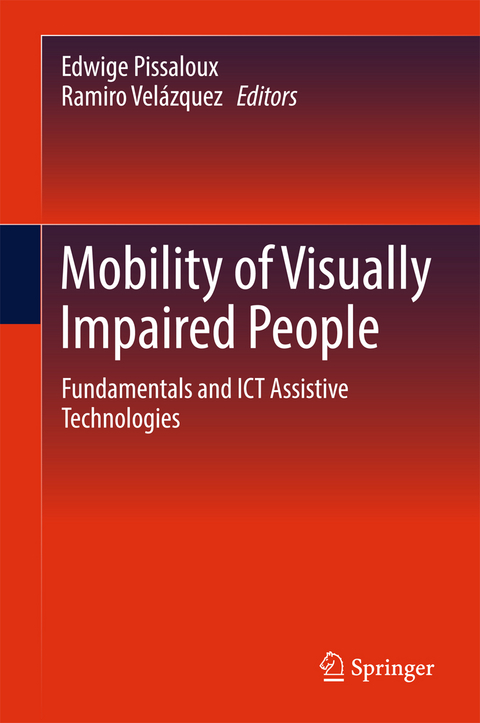
Mobility of Visually Impaired People
Springer International Publishing (Verlag)
978-3-319-54444-1 (ISBN)
Edwige Pissaloux is a Full Professor at the University of Rouen, Physics Department, and closely collaborates with the ISIR (Institute for Intelligent Systems and Robotics) at Paris-Sorbonne University and the MIT (France-MIT program). She has authored more than 250 journals and conferences papers. Prof. Pissaloux main research interests are the modeling and design of vision systems, cognitive perception systems, and cognitive mobility systems. Her research has been supported by European funds (EU FP7 Research and Innovation Funding Program), national funds (CNRS, CEA), and international projects (France-UK-Mexico). Prof. Pissaloux is a member of several international advisory boards of universities and research institutes, and teaches in several universities (Australia, Hong-Kong, Canada). She frequently acts as an international expert for several research bodies and international institutions such as the European Commission, NSF/USA, Canada, UK, Australia, China, Switzerland, etc.Prof. Pissaloux initiated a series of national conferences such as “Space and its perception: application to design of assistive technologies” or “Eye, gaze and interaction”. She has participated and/or co-animated European Excellence networks.In her free time, Prof. Pissaloux teaches violin for visually impaired children.Ramiro Velázquez is an Associate Professor at the Faculty of Engineering of Universidad Panamericana (Aguascalientes, Mexico). He is past Dean of the Faculty of Engineering and currently serves as Vice-President for Research and member of the Board of Governors of this university.He obtained the PhD in Robotics from UPMC-Paris 6 Sorbonne University in 2006. He has authored more than 100 journals and conferences papers. Prof. Velázquez main research interests are assistive technologies, haptic and tactile devices, mechatronic systems, and human-computer interaction. His research projects in assistive devices for visually impaired and blind people have been featured in IEEE Spectrum, CNN, and BBC Horizons. Prof. Velázquez frequently serves as an expert evaluator for the European Commission, CONACYT (Mexico), and COLCIENCIAS (Colombia). He is a member of the Mexican National Systems of Researchers (SNI-Level I).
Introduction.- Part 1. Space for mobility and its conscious perception.- Living in Space. A phenomenological account.- Technologies to access space without vision. Some empirical facts and guiding theoretical principles.- Mobility technologies for visually impaired people through the prism of classic theories of perception.- Part 2. Neuro-cognitive basis of space perception for mobility.- The multisensory brain.- On spatial knowledge and mobility strategies.- Sensory substitution and the Neural Correlates of navigation in the Blindness.- Visuo-Vestibular and Somesthetic Contributions to Spatial Navigation in Children and Adults.- Mobility of the visually impaired.- Orientation and Mobility training to people with Visual Impairments.- Spatial orientation in children: tyflological approach.- Scene representation for mobility of visually impaired.- Model of cognitive mobility for visually impaired people and its experimental validation.- Solid: A Model to Analyse the Accessibility of Transport Systems for the Visually Impaired.- Part 4. ICT technologies and mobility.- Mobility technologies: design issues.- Co-design toghether with persons with visual impairment.- Technologies for mobility assistance.- Different approaches to aiding blind persons in mobility and navigation in the "Naviton" and "Sound of Vision" projects.- Overview of smart white canes: connected smart cane from front-end to back-end.- Accessible Interactive Maps.- Smart multisensory strategies for indoor localization.- Constructing Tactile Languages for Situational Awareness Assistance of Visually Impaired People.- Vision restoration with implants.- Mobility, Inclusion, Exclusion.- Conclusion.
| Erscheinungsdatum | 15.09.2017 |
|---|---|
| Zusatzinfo | XIX, 652 p. 160 illus., 109 illus. in color. |
| Verlagsort | Cham |
| Sprache | englisch |
| Maße | 155 x 235 mm |
| Gewicht | 1117 g |
| Themenwelt | Technik ► Elektrotechnik / Energietechnik |
| Schlagworte | biomedical engineering • Engineering • Engineering: general • ICT Technologies for Mobility • Imaging Systems & Technology • Imaging Systems & Technology • Interaction via Mobility • Mobility Assistive Device • Mobility of Visually Impaired • Mobility Strategies • Neuro-cognitive • Signal, Image and Speech Processing • Signal Processing • Space Perception • user interface design & usability • User interface design & usability • user interfaces and human computer interaction |
| ISBN-10 | 3-319-54444-6 / 3319544446 |
| ISBN-13 | 978-3-319-54444-1 / 9783319544441 |
| Zustand | Neuware |
| Haben Sie eine Frage zum Produkt? |
aus dem Bereich


